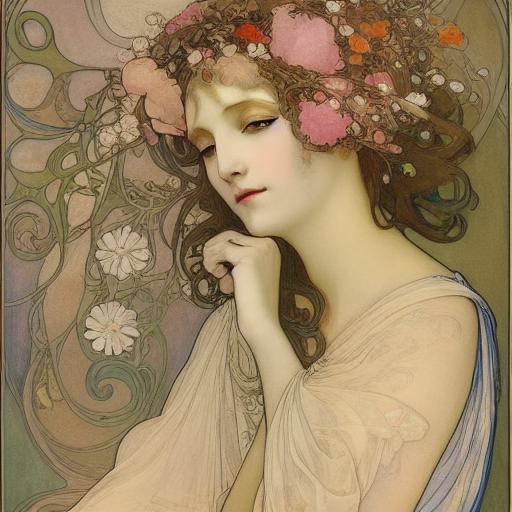Create Art Nouveau painting with AI image generator
When generating an AI image, the prompt “a painting of a woman with flowers in her hair, an art nouveau painting, Alphonse Mucha, elegant, artistic, long dress” provides specific details and influences the outcome of the generated painting.
The prompt sets the focus on a painting featuring a woman adorned with flowers in her hair. The mention of “art nouveau” indicates a specific artistic style known for its intricate and decorative elements. This style, pioneered by Alphonse Mucha, is characterized by flowing lines, ornate details, and a celebration of nature.
The inclusion of the keyword “elegant” suggests a refined and graceful aesthetic, enhancing the overall sophistication of the artwork. It directs the AI image generator to emphasize the woman’s poise and beauty, capturing an aura of elegance.
The term “artistic” implies a focus on expressive and creative elements within the painting. It encourages the AI image generator to incorporate unique and visually captivating elements that showcase the artist’s skill and vision.
The prompt also mentions the woman wearing a “long dress,” which adds a sense of grace and timeless beauty to the composition. The flowing lines of the dress can further enhance the art nouveau style, allowing for intricate patterns and organic forms to be woven into the fabric.
By incorporating these elements into the prompt, the AI image generator like Stable Diffusion and DALL-E will then generate an image that fit the keywords. We can then share it with others directly, or adjust it and use it as part of the elements in other design tool, such as Visual Paradigm Online.
About Art Nouveau
Art Nouveau, also known as the “New Art,” was a prominent artistic movement that emerged in the late 19th century and flourished until the early 20th century. It was characterized by its distinctive style that embraced decorative and organic forms inspired by nature, as well as a desire to break away from the traditional artistic conventions of the time. Art Nouveau encompassed various art forms, including architecture, interior design, furniture, jewelry, and visual arts.
At the heart of Art Nouveau was a fascination with curvilinear lines, intricate patterns, and intricate details. Artists sought to create harmonious and flowing compositions, often featuring motifs derived from plant life, such as flowers, vines, and leaves. The emphasis on organic forms and natural elements resulted in a sense of dynamism and vitality in Art Nouveau artworks. This style often employed rich and vibrant colors, incorporating a range of hues to evoke a sense of opulence and luxuriousness.
Art Nouveau was a revolutionary movement that rejected the rigidity of traditional artistic styles and embraced a more fluid and innovative approach to design. It had a profound influence on the decorative arts and left an indelible mark on architecture and design in cities around the world. The movement’s commitment to craftsmanship, attention to detail, and integration of art into everyday life made it a significant precursor to modern design movements. Today, Art Nouveau continues to captivate and inspire with its exquisite beauty and its celebration of nature’s organic forms.
Style of Alphonse Mucha
Alphonse Mucha, a Czech artist, was one of the most prominent figures associated with the Art Nouveau movement. His distinctive style and iconic works have come to epitomize the essence of Art Nouveau. Mucha’s creations often featured elegant, elongated female figures adorned in flowing robes, surrounded by intricate patterns and decorative elements.
Mucha’s artistic approach focused on capturing the beauty of the female form and its harmonious integration with nature. He incorporated organic motifs such as flowers, vines, and leaves into his compositions, reflecting the Art Nouveau fascination with the natural world. Mucha’s attention to detail was remarkable, as he meticulously rendered every element, from the delicate facial features of his subjects to the elaborate patterns that adorned their garments.
One of Mucha’s notable contributions to the Art Nouveau style was his use of decorative frames and panels that framed and showcased his subjects. These frames often incorporated curvilinear lines, geometric shapes, and ornate designs, enhancing the overall aesthetic appeal of his works. Mucha’s use of vibrant colors, particularly rich jewel tones, further added to the allure of his pieces, creating a sense of opulence and enchantment.
Through his distinct style, Mucha sought to elevate everyday objects and bring art into all aspects of life. His works extended beyond traditional canvases and encompassed various forms, including posters, advertisements, book illustrations, and even theater sets. Mucha’s unique vision and artistic sensibility made him a leading figure in the Art Nouveau movement and continue to inspire artists and admirers alike to this day.


